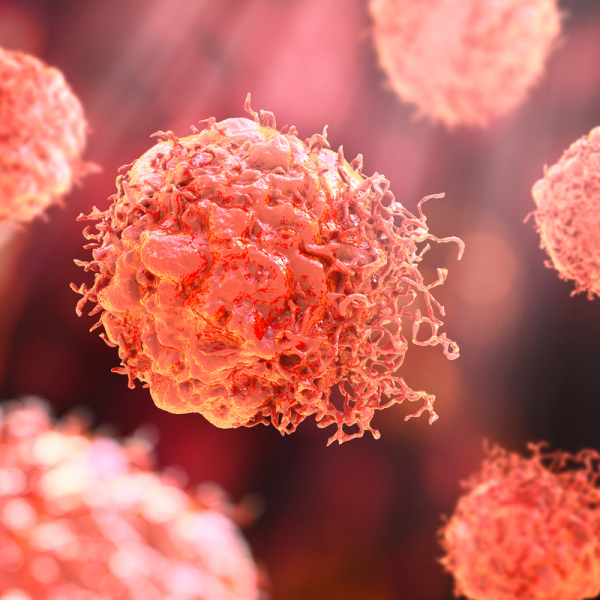
What is a carcinoid?
A carcinoid is a group of tumours that have developed from cells of the diffuse neuroendocrine system (DNES). This rather rare tumour develops from hormone-producing cells, which in turn often produce hormones and messenger substances. A carcinoid is also often called a neuroendocrine tumour (NET) and manifests itself as flushing of the skin, diarrhoea and/or spasm of the airways (bronchospasm).
Carcinoids grow slowly and usually have a low malignancy grade. If the tumour has a diameter of less than one centimetre and does not take on vascular invasive growth, it is considered benign. However, a carcinoid can also degenerate. In many cases, carcinoids remain undetected for a long time, but are completely curable if diagnosed and treated early.
What are the malignancy criteria for a carcinoid?
The following malignancy criteria are distinguished in carcinoids:
- outgrowth of the tumour beyond the thin connective tissue layer below the mucosa (submucosa),
- angio-invasive growth,
- Formation of metastases,
Where does a carcinoid form?
Carcinoids occur predominantly in the gastrointestinal tract with the following percentage distribution:
- in the vermiform appendix (45%),
- in the lower part of the small intestine (ileum - 28%),
- in the rectum (16%),
- in the duodenum (5%),
- in the stomach (2%),
- in the lungs (1%).
Malignant (malignant) carcinoids often form in the lower part of the small intestine (ileum).
What forms are carcinoids divided into?
Carcinoids are differentiated by doctors as follows:
- neuroendocrine tumours (benign): usually arise from hormone-producing cells,
- highly differentiated neuroendocrine carcinomas (low-malignant),
- dedifferentiated neuroendocrine carcinomas (highly malignant)
What causes a carcinoid?
The specific causes of carcinoids are still largely unknown. Since carcinoids only occur very rarely, no connections with environmental influences, hereditary factors or viruses have yet been discovered. Even through the recommended early detection examinations, it is not yet possible to prevent a carcinoid.
What symptoms do carcinoids cause?
As a rule, carcinoids do not cause any symptoms. Only in about ten percent of all cases of the disease can symptoms occur that are related to the production of hormones. These include
- a hot flush with reddening of the skin, which can affect the facial area, but also the neck and upper body (flush),
- Diarrhoea,
- Bronchoconstriction or asthma attacks,
- increased heartbeat (tachycardia)
Most often, the symptoms are triggered by food intake, psychological as well as physical stress and/or alcohol consumption.
How is carcinoid diagnosed?
An elevated chromogranin A and serotonin level can be detected by a urine examination. If the level is above 15 mg within 24 hours, this can indicate a carcinoid. In addition to the urine examination, imaging procedures are also used to diagnose the primary tumour of the carcinoid, or the metastases. An ultrasound examination (sonography), but also computer tomography (CT) and endoscopy are among the usual procedures here.
How is a carcinoid treated?
In most cases, a carcinoid and individual metastases are removed surgically. If there are multiple metastases, chemotherapy is also carried out after the operation, even though (partial) tumour regression only occurs in about one third of all patients. In the case of bone metastases, radiotherapy can be carried out. In the case of liver metastases, on the other hand, an attempt is made to destroy the metastases by artificially closing off the blood vessels (embolisation - TACE) or to inhibit their growth by cutting off their blood supply.
So-called immunotherapy is also suitable for treating carcinoids. This is intended to stimulate the immune system to direct its defences against the tumour tissue. Doctors often use so-called somatostatin analogues for immunotherapy. These are active substances that resemble the body's own hormone somatostatin and have the purpose of reducing the excessive hormone secretion in the cells of the carcinoid. In many cases, this can alleviate the symptoms of the disease.
What is the general course of the disease?
The general course of a carcinoid depends on the type of tumour, its location and its stage of development. As a rule, carcinoids grow rather slowly, which in turn has a positive effect on the chances of cure. If it is a carcinoid of the appendix, metastases often form. If the appendix carcinoma is completely removed in an operation, the prognosis is usually good. But even with other carcinoids, which may have already metastasised, the course of the disease can often be controlled well for a long time with medication.
If a carcinoid remains untreated, it can lead to various complications in the further course of the disease. For example, metastases can form in the body via the lymphatic and blood vessels. The liver and bones are particularly at risk. But metastases can also occur in the eye socket, in the heart muscle and in the female breast. If it is a particularly large carcinoid, or large metastases, the surrounding tissue can be displaced - with sometimes even life-threatening consequences.
What is the prognosis for a carcinoid?
The prognosis depends on the individual course of the disease, but also on the stage of development at which the diagnosis was made. If the carcinoid has not yet metastasised at the time of diagnosis, it is possible that the patient will be completely cured by surgery. If, on the other hand, the carcinoid has already metastasised to other organs, there are various treatment options that can often delay the progression of the disease for many years.
